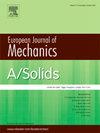受旋转分解启发的超材料:通过无量纲卡恩-希利亚德方程定制均质弹性特性
IF 4.4
2区 工程技术
Q1 MECHANICS
引用次数: 0
摘要
超材料由于其在建筑设计中表现出的特殊性能而越来越受到关注。其中,受最小表面结构启发的spinodal拓扑,代表了一种来自某些金属合金中发生的spinodal分解过程的新类别。在超材料研究中,spinodal分解过程通常是用统计方法来近似的,例如高斯随机场的叠加,这些方法只在现象的初始阶段有效。在这项研究中,我们通过解决由Cahn-Hilliard偏微分方程(PDE)控制的全非线性动态演化,推进了由旋量分解启发的超材料的探索。虽然在独立分解的自然尺度上解决这种非线性偏微分方程通常需要特别的算法,但我们的方法侧重于更大数量级的尺度-那些与超材料生产相关的尺度。这种尺度调整允许我们使用简单的有限差分算法,这种算法计算效率高,非常适合感兴趣的结构尺度。为了设计具有定制弹性性能的超材料,我们以无量纲形式求解Cahn-Hilliard方程,该方程由两个关键的无量纲参数控制。然后通过专用算法将生成的解场转换为CAD模型,使后续的有限元分析(FEA)能够提取所得结构的均匀弹性特性。我们的分析探讨了二维参数的变化如何影响超材料单元胞的各向异性弹性特性。通过构建这些特性的响应面,我们实现了反向均质化方法,从而可以设计具有目标机械特性的材料。这种能力提供了对材料设计领域感兴趣的超材料弹性行为的精确控制。最后,数值和实验验证证明了所提出的均匀化框架在预测位移场方面的准确性,即使对于复杂拓扑的spinodal分解启发的超材料也是如此。本文章由计算机程序翻译,如有差异,请以英文原文为准。

Spinodal decomposition-inspired metamaterial: Tailored homogenized elastic properties via the dimensionless Cahn-Hilliard equation
Metamaterials are increasingly gaining attention due to their ability to exhibit exceptional properties through architectural design. Among these, spinodal topologies, inspired by minimal surface structures, represent a novel class derived from the spinodal decomposition process occurring in certain metal alloys. In metamaterials research, the spinodal decomposition process is typically approximated using statistical methods, such as the superposition of Gaussian random fields, which are only valid during the initial stages of the phenomenon. In this study, we advance the exploration of metamaterials inspired by spinodal decomposition by addressing the full nonlinear dynamic evolution governed by the Cahn-Hilliard partial differential equation (PDE). While solving this nonlinear PDE at the natural scales of spinodal decomposition usually demands ad hoc algorithms, our approach focuses on scales orders of magnitude larger—those relevant to the production of metamaterials. This scale adjustment allows us to employ a straightforward finite difference algorithm, which is computationally efficient and well-suited to the structural scales of interest. To design metamaterials with tailored elastic properties, we solve the Cahn-Hilliard equation in its dimensionless form, governed by two key dimensionless parameters. The solution fields generated are then transformed into CAD models via a dedicated algorithm, enabling subsequent finite element analysis (FEA) to extract the homogenized elastic properties of the resulting structures. Our analysis investigates how variations in the two dimensionless parameters influence the anisotropic elastic properties of the metamaterial unit-cell. By constructing response surfaces for these properties, we enable a reverse homogenization approach, allowing to design materials with targeted mechanical characteristics. This capability offering precise control over the elastic behavior of metamaterials, of interest in the field of material design. Finally, numerical and experimental validations demonstrate the accuracy of the proposed homogenization framework in predicting displacement fields, even for the complex topologies of spinodal decomposition-inspired metamaterial.
求助全文
通过发布文献求助,成功后即可免费获取论文全文。
去求助
来源期刊
CiteScore
7.00
自引率
7.30%
发文量
275
审稿时长
48 days
期刊介绍:
The European Journal of Mechanics endash; A/Solids continues to publish articles in English in all areas of Solid Mechanics from the physical and mathematical basis to materials engineering, technological applications and methods of modern computational mechanics, both pure and applied research.

 求助内容:
求助内容: 应助结果提醒方式:
应助结果提醒方式:


